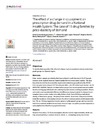Please use this identifier to cite or link to this item:
https://accedacris.ulpgc.es/jspui/handle/10553/69247
| DC Field | Value | Language |
|---|---|---|
| dc.contributor.author | Hernández Izquierdo, Cristina | en_US |
| dc.contributor.author | González Lopez-Valcarcel, Beatriz | en_US |
| dc.contributor.author | Morris, Stephen | en_US |
| dc.contributor.author | Melnychuk, Mariya | en_US |
| dc.contributor.author | Abásolo Alesson, Ignacio | en_US |
| dc.date.accessioned | 2020-01-23T09:14:34Z | - |
| dc.date.available | 2020-01-23T09:14:34Z | - |
| dc.date.issued | 2019 | en_US |
| dc.identifier.issn | 1932-6203 | en_US |
| dc.identifier.other | WoS | - |
| dc.identifier.uri | https://accedacris.ulpgc.es/handle/10553/69247 | - |
| dc.description.abstract | Objectives: To test the heterogeneity of the effect of a change in pharmaceutical cost-sharing by therapeutic groups in a Spanish region. Methods: Data: random sample (provided by the Canary Islands Health Service) of 40,471 people covered by the Spanish National Health System (SNHS) in the Canary Islands. The database includes individualised monthly-dispensed medications (prescribed by the SNHS) from one year before (August 2011) to one year after (June 2013) the Royal Decree Law 16/ 2012 (RDL 16/2012). Sample: two intervention groups (low-income pensioners and middleincome working population) and one control group (low-income working population). Empirical model: quasi-experimental difference-in-differences design to study the change in consumption (measured in number of monthly Defined Daily Dose (DDDs) per individual) among 13 therapeutic groups. The policy break indicator (three-level categorical variable) tested the existence of stockpiling between the reform’s announcement and its implementation. We ran 16 linear regression models (general, by therapeutic groups and by comorbidities) that considered whether the exclusion of some drugs from public provision impacted on consumption more than the co-payment increase. Results: General: Reduction (-13.04) in consumption after the reform’s implementation, which was fully compensated by a previous increase (16.60 i.e., stockpiling) among low-income pensioners. The middle-income working population maintained its trend of increasing consumption. Therapeutic groups: Reductions in consumption after the reform’s implementation among low-income pensioners in 7 of the 13 groups, which were fully compensated for by a previous increase (i.e., stockpiling) in 4 groups and partially compensated for in the remaining 3. The analysis without the excluded medicines provided fewer negative coefficients. Comorbidities: Reduction in consumption that was only slightly compensated for by a previous increase (i.e., stockpiling). Conclusions: The negative impact of cost-sharing produced, among low-income pensioners, a risk of loss of adherence to treatments, which could deteriorate the health status of individuals, especially among pensioners within the most inelastic therapeutic groups (associated with chronic diseases) and patients with comorbidities (also, associated with chronic diseases). Notwithstanding the above, this risk was more related to the exclusion of some drugs from provision than to the cost-sharing increase. | en_US |
| dc.language | eng | en_US |
| dc.relation.ispartof | PLoS ONE | en_US |
| dc.source | Plos One[ISSN 1932-6203],v. 14 (3) | en_US |
| dc.subject | 531207 Sanidad | en_US |
| dc.subject.other | Care utilization | en_US |
| dc.subject.other | Free medicines | en_US |
| dc.subject.other | Gasto farmaceútico | en_US |
| dc.subject.other | España | en_US |
| dc.title | The effect of a change in co-payment on prescription drug demand in a National Health System: the case of 15 drug families by price elasticity of demand | en_US |
| dc.type | info:eu-repo/semantics/Article | en_US |
| dc.type | Article | en_US |
| dc.identifier.doi | 10.1371/journal.pone.0213403 | |
| dc.identifier.scopus | 85063564937 | |
| dc.identifier.isi | 000462465800032 | - |
| dc.contributor.authorscopusid | 57208016661 | |
| dc.contributor.authorscopusid | 57195150724 | |
| dc.contributor.authorscopusid | 56449994300 | |
| dc.contributor.authorscopusid | 57192157442 | |
| dc.contributor.authorscopusid | 6602352170 | |
| dc.identifier.issue | 3 | - |
| dc.relation.volume | 14 | - |
| dc.investigacion | Ciencias Sociales y Jurídicas | en_US |
| dc.type2 | Artículo | en_US |
| dc.contributor.daisngid | 29893739 | |
| dc.contributor.daisngid | 7008994 | |
| dc.contributor.daisngid | 1125760 | |
| dc.contributor.daisngid | 28199935 | |
| dc.contributor.daisngid | 17767967 | |
| dc.utils.revision | Sí | en_US |
| dc.contributor.wosstandard | WOS:Hernandez-Izquierdo, C | |
| dc.contributor.wosstandard | WOS:Lopez-Valcarcel, BG | |
| dc.contributor.wosstandard | WOS:Morris, S | |
| dc.contributor.wosstandard | WOS:Melnychuk, M | |
| dc.contributor.wosstandard | WOS:Alesson, IA | |
| dc.date.coverdate | Marzo 2019 | |
| dc.identifier.ulpgc | Sí | es |
| dc.description.sjr | 1,1 | |
| dc.description.jcr | 2,776 | |
| dc.description.sjrq | Q1 | |
| dc.description.jcrq | Q2 | |
| dc.description.scie | SCIE | |
| dc.description.erihplus | ERIH PLUS | |
| item.grantfulltext | open | - |
| item.fulltext | Con texto completo | - |
| crisitem.author.dept | GIR Economía de la salud y políticas públicas | - |
| crisitem.author.dept | Departamento de Métodos Cuantitativos en Economía y Gestión | - |
| crisitem.author.orcid | 0000-0002-5571-3257 | - |
| crisitem.author.parentorg | Departamento de Métodos Cuantitativos en Economía y Gestión | - |
| crisitem.author.fullName | González Lopez-Valcarcel, Beatriz | - |
| Appears in Collections: | Artículos | |
SCOPUSTM
Citations
13
checked on Jun 8, 2025
WEB OF SCIENCETM
Citations
11
checked on Jun 8, 2025
Page view(s)
96
checked on May 23, 2024
Download(s)
110
checked on May 23, 2024
Google ScholarTM
Check
Altmetric
Share
Export metadata
Items in accedaCRIS are protected by copyright, with all rights reserved, unless otherwise indicated.
